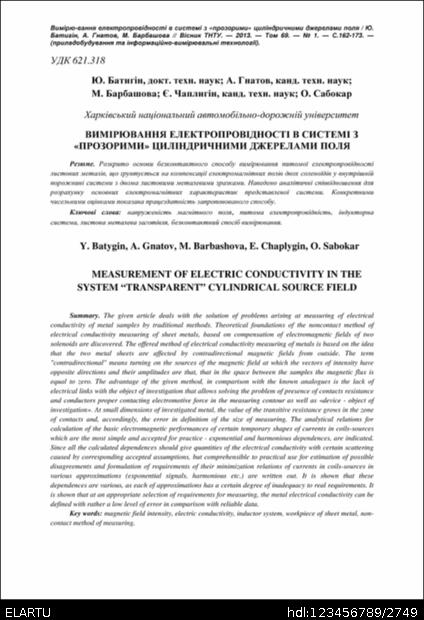Моля, използвайте този идентификатор за цитиране или линк към този публикация:
http://elartu.tntu.edu.ua/handle/123456789/2749

| Заглавие: | Вимірювання електропровідності в системі з «прозорими» циліндричними джерелами поля |
| Други Заглавия: | Measurement of electric conductivity in the system “transparent” cylindrical source field |
| Автори: | Батигін, Юрій Вікторович Гнатов, Андрій Вікторович Барбашова, Марина Вікторівна Чаплигін, Євген Олександрович Сабокар, Олег Сергійович Batygin, Y. Gnatov, A. Barbashova, M. Chaplygin, E. Sabokar, O. |
| Bibliographic description (Ukraine): | Вимірю-вання електропровідності в системі з «прозорими» циліндричними джерелами поля / Ю. Батигін, А. Гнатов, М. Барбашова // Вісник ТНТУ. — 2013. — Том 69. — № 1. — С.162-173. — (приладобудування та інформаційно-вимірювальні технології). |
| Дата на Публикуване: | 13-Дек-2012 |
| Date of entry: | 21-Яну-2014 |
| Издател: | Тернопільський національний технічний університет ім. Івана Пулюя |
| Place of the edition/event: | Тернопіль, Україна |
| UDC: | 621.318 |
| Ключови Думи: | напруженість магнітного поля питома електропровідність індукторна система листова металева заготівля безконтактний спосіб вимірювання magnetic field intensity electric conductivity inductor system workpiece of sheet metal non-contact method of measuring |
| Резюме: | Розкрито основи безконтактного способу вимірювання питомої електропровідності листових металів, що ґрунтується на компенсації електромагнітних полів двох соленоїдів у внутрішній порожнині системи з двома листовими металевими зразками. Наведено аналітичні співвідношення для розрахунку основних електромагнітних характеристик представленої системи. Конкретними чисельними оцінками показана працездатність запропонованого способу. The given article deals with the solution of problems arising at measuring of electrical conductivity of metal samples by traditional methods. Theoretical foundations of the noncontact method of electrical conductivity measuring of sheet metals, based on compensation of electromagnetic fields of two solenoids are discovered. The offered method of electrical conductivity measuring of metals is based on the idea that the two metal sheets are affected by contradirectional magnetic fields from outside. The term "contradirectional" means turning on the sources of the magnetic field at which the vectors of intensity have opposite directions and their amplitudes are that, that in the space between the samples the magnetic flux is equal to zero. The advantage of the given method, in comparison with the known analogues is the lack of electrical links with the object of investigation that allows solving the problem of presence of contacts resistance and conductors proper contacting electromotive force in the measuring contour as well as «device - object of investigation». At small dimensions of investigated metal, the value of the transitive resistance grows in the zone of contacts and, accordingly, the error in definition of the size of measuring. The analytical relations for calculation of the basic electromagnetic performances of certain temporary shapes of currents in coils-sources which are the most simple and accepted for practice - exponential and harmonious dependences, are indicated. Since all the calculated dependences should give quantities of the electrical conductivity with certain scattering caused by corresponding accepted assumptions, but comprehensible to practical use for estimation of possible disagreements and formulation of requirements of their minimization relations of currents in coils-sources in various approximations (exponential signals, harmonious etc.) are written out. It is shown that these dependences are various, as each of approximations has a certain degree of inadequacy to real requirements. It is shown that at an appropriate selection of requirements for measuring, the metal electrical conductivity can be defined with rather a low level of error in comparison with reliable data. |
| URI: | http://elartu.tntu.edu.ua/handle/123456789/2749 |
| ISSN: | 1727-7108 |
| Copyright owner: | © „Вісник Тернопільського національного технічного університету“ |
| Publications status : | Опубліковано раніше |
| Content type: | Article |
| Показва се в Колекции: | Вісник ТНТУ, 2013, № 1(69) |
Файлове в Този Публикация:
Публикацияте в DSpace са защитени с авторско право, с всички права запазени, освен ако не е указно друго.